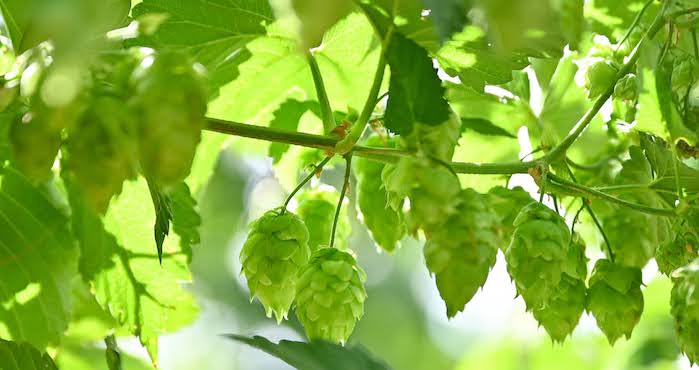Hop Science Newsletter (March 2021)
Read about dry-hopping as a solution for the flavour gap in non-alcoholic beer, and possible options for isomerization.

FIRSTLY THE GENES, SECONDLY MATURITY
This is a very brief summary of the very extensive research of an international research group. The have screened the monoterpene diglycosides in 5 different cultivars from different locations and harvested at different time points during harvest season. Monoterpene alcohol glycosides were isolated and semi-quantitatively measured in dried Humulus lupulus cones using UHPLC-qTOF-MS/MS and HPLC fractionation followed by GC–MS. They found that hop variety accounted for the biggest variation among the concentrations of pentose-hexose monoterpene alcohol glycosides as well as other volatile and nonvolatile chemical factors measured in the samples. This indicates that genetics plays a major role in hop flavor production. Interestingly, “maturity”, or ripeness at the time of harvest, was the next most significant factor impacting the concentrations of pentose-hexose monoterpene alcohol glycosides along with most of the other volatile and nonvolatile factors (such as total oil concentration and composition). These results highlight the importance of breeding/genetics as well as considering hop maturity/ripeness at the time of harvest for the production and subsequent development of analytical chemical factors associated with driving hoppy beer flavor.¹
DRY HOPPING AS THE SOLUTION FOR THE FLAVOUR GAP IN ALCOHOL FREE BEERS
Alcohol-free beer is a good alternative to water or sodas but not necessarily for beer, because something is often missing. There are two things: mouthfeel and flavour. There are mainly two ways to produce alcohol-free beer: evaporation of ethanol by heat treatment, losing all the good aroma, and stopped fermentation that leads to beers still containing high amounts of unfermented sugar and only low amounts of aroma-active fermentation products. Dry hopping trials with Mandarina Bavaria, Hallertauer Cascade, or Hallertauer Mittelfrüh in top- and bottom-fermented alcohol-free beers either after thermal dealcoholization or stopped fermentation showed the following: Thermally dealcoholized samples showed high losses (up to 100%) of key odorants like 3-methyl-1-butanol or 3-methylbutyl acetate. During stopped fermentation, aroma compounds like ethyl butanoate or 2-phenylethanol were formed in higher but still relatively low concentrations compared to beers with normal alcohol contents. Dry hopping resulted in high transfer rates for the quantified hop derived aroma compounds. Furthermore, hop addition apparently induced the formation of ethyl esters of hop-derived monocarboxylic acids. So, in terms of flavor, dry hopping can compensate a lot.²
WHERE TO ISOMERISE—THAT IS THE QUESTION
Traditionally, isomerization takes place during boiling in the brewhouse, but this is just one of many options for isomerization. This German research team investigated further possible additions of hops in the brewing process for isomerization together with many strategies to increase hop isomerization. Options are the adaptation of temperature management, for example, at mashing-off as well as a pre-isomerization and parallel hop systems, which are utilized to increase the hop yield in the brewhouse. It is not yet clarified what effect the non-degraded starch has on the final product, as the enzymes are inactivated at a mashing-off temperature of 95 °C instead of 78 °C. The authors present two hop systems for increasing hop yield in the brewhouse. For the utilization of such systems in the brewhouse, the existing equipment must be taken into account and an appropriate selection made. This review provides an overview of practical applications for increasing hop yield, but not all options appear to be profitable or applicable for every brewery.3
REFERENCES
1. Scott Lafontaine et al: Evaluation of Variety, Maturity, and Farm on the Concentrations of Monoterpene Diglycosides and Hop Volatile/Nonvolatile Composition in Five Humulus lupulus Cultivars, Journal of Agricultural and Food Chemistry Article ASAP DOI: 10.1021/acs.jafc.0c07146
2. Sabrina Brendel, Thomas Hofmann, and Michael Granvogl, Dry-Hopping to Modify the Aroma of Alcohol-Free Beer on a Molecular Level—Loss and Transfer of Odor-Active Compounds, Journal of Agricultural and Food Chemistry 2020 68 (32), 8602-8612 DOI: 10.1021/acs.jafc.0c01907
3. Nele Bastgen, Tobias Becher, Stephan Drusch & Jean Titze (2021) Usability and Technological Opportunities for a Higher Isomerization Rate of α-Acids: A Review, Journal of the American Society of Brewing Chemists, 79:1, 17-25, DOI: 10.1080/03610470.2020.1840893
